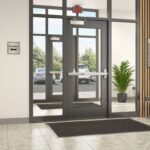This Quick Question has come up quite often over the years – I was shocked to find that I had not yet answered it here:
Is XYZ product certified as compliant with NFPA 101 (or any other model code)?
No matter which piece of hardware or model code we’re talking about, the short answer is no. Products are not certified to NFPA 101 – Life Safety Code, the International Building Code (IBC), or the International Fire Code (IFC). The same goes for many referenced standards, like NFPA 80 – Standard for Fire Doors and Other Opening Protectives, and ICC A117.1 – Accessible and Usable Buildings and Facilities. These are not test standards. Doors, frames, and hardware are not tested or certified to these publications.
 Here’s an example: I was recently asked whether a particular electric strike was certified to NFPA 101. Let’s not get hung up on the word “certified” (as I said before, the answer is no) – I can’t say whether the strike is compliant with NFPA 101 either. The answer depends on the application:
Here’s an example: I was recently asked whether a particular electric strike was certified to NFPA 101. Let’s not get hung up on the word “certified” (as I said before, the answer is no) – I can’t say whether the strike is compliant with NFPA 101 either. The answer depends on the application:
- What kind of lockset is being used along with the electric strike? Is it a function that allows free egress without the use of a key, tool, special knowledge or effort?
- Is the strike being installed as part of a fire door assembly? If so, is it fail secure and listed to UL 10C?
- Is it a fire door that needs to allow for stairwell reentry and also remain positively latched?
- Does the opening require panic hardware, and if yes, is the strike of the correct type?
- Does the door unlatch with one releasing motion, and without tight grasping, pinching, or twisting of the wrist?
- Is the releasing hardware mounted between 34 inches and 48 inches above the floor?
The list of questions goes on and on, and it’s up to the hardware consultant or other professional responsible for product selection to determine whether a particular application meets the requirements of the adopted code or reference standard. There is no simple answer or certification to verify this – if it was easy, it would be called easyware! 😀
Note that some standards referenced in the model codes ARE test standards – products may be certified to these standards. For example, NFPA 101 requires panic hardware to comply with ANSI/BHMA A156.3 – Exit Devices. To determine whether a particular panic device is compliant, you can refer to the BHMA Certified Products Directory. The same applies to test standards like UL 10C – Standard for Positive Pressure Fire Tests of Door Assemblies. The list of products certified to this standard can be found in UL’s Product iQ database.
Any questions?
You need to login or register to bookmark/favorite this content.









“The list of questions goes on and on”
It called Hard-Ware because its not easy.
Lock Brand, Grade, Type, Fire Rated, Style, Color, Finish, Function, Backset, Key Cyl Prep, Keyway?
The list of questions for LOCKS goes on and on
now we need to question
Frames, Doors, Exit Device (Panic Bar), Trims, Hinges, Strikes, Latch Guards, Kick Plates, Closers, Coordinators, Flush Bolts, Stops, Holders, Thresholds, Smoke Seal, Sweeps, Vision Lites, Louvers.
The list of questions goes on and on…..
Hardware Not Easyware
I agree, Charlie!
– Lori